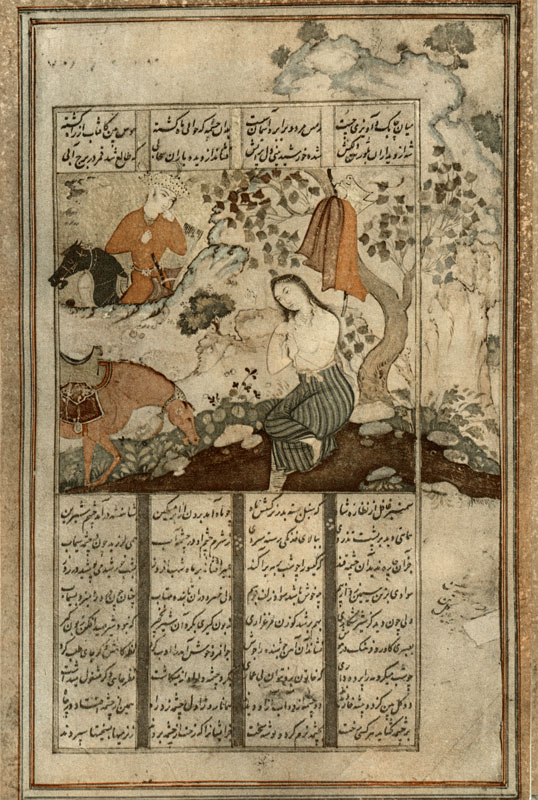Ḵosrow Parviz Spies Širin Bathing
The illustration depicts the story at the customary point in the narrative long a traditional favorite of the Persian painter. Širin is portrayed in the right foreground, naked above the waist, wearing only a pair of baggy, striped, men’s pantaloons, with the remainder of her male hunting attire slung over the branch of a tree just behind her. She sits at the edge of a pool which occupies the foreground, its silver waters having oxidized to gray. The forequarters of her saddled horse Šabdiz can be seen on the left, bending to take a drink from the pool. Although the text specifically states that Šabdiz was black, the horse is here shown brown. Serving as a backdrop to Širin and her mount is a neutral colored rock formation, tipped with turquoise and accented with a few small bushes that extend beyond the frame into the right and upper margins. Beyond the ridge in the left background, the solitary figure of Ḵosrow Parviz sits, astride a black mount, silhouetted against a gold sky, with his forefinger to his lip in a sign of astonishment as he gazes at the beauty before him. He wears a crown, symbol of his princely position, but in contradiction to the text, is still attired in his red coat.
The dimensions of the painting or page are not known, There are four columns of text comprised of two lines above the painting, and nine lines below. A rectangular frame encloses painting and text, except on the right side where the composition continues into the right and upper margins uninhibited by the frame. A second, larger frame surrounds the first and the margins on each side. The text has been smeared in a few places, the lower right corner of the page has been creased, and a small repair(?) has been made in the right margin near the bottom. Partly damaged by the repair is a marginal inscription that is illegible in the reproduction in Kubicova. The page is signed in the lower margin, in what seems to be Moʿin’s hand: raqam zad kamina moʿin-e moṣavver. The painting has been attributed to Moʿin by Kubicova and Stchoukine. It is impossible to judge the quality of the painting and authenticity of the attribution from the reproduction in Kubicova, but the style and detailing that is discernible conforms to Moʿin’s work, and it may well be that the attribution is correct. No date is recorded, and there is little stylistic evidence to date it with any degree of certainty, but circa 1660 might be considered.
Location:
Kubicova states that the page is in The Archaeological Museum in Tehran. However, the Iran Bastam claims that the painting is not in their collection.
Bibliography:
Kubicova, PM_1960, plate 36 (in color), and p.68.
Stchoukine, SA_1964, p.66 (not ill.).
Text references:
Chelkowski, Khamseh_1975, pp.22-27.
Robert Eng
Last Updated: April 26, 2011 | Originally published: April 26, 2011
